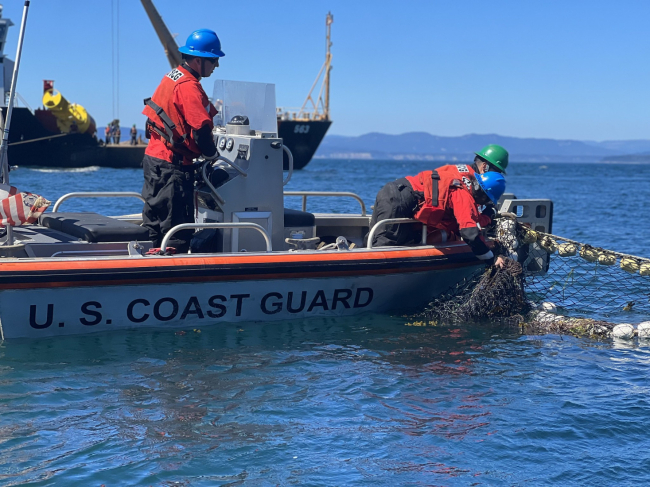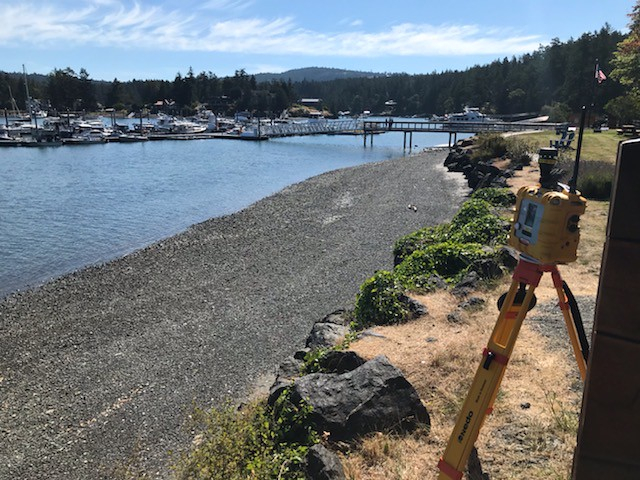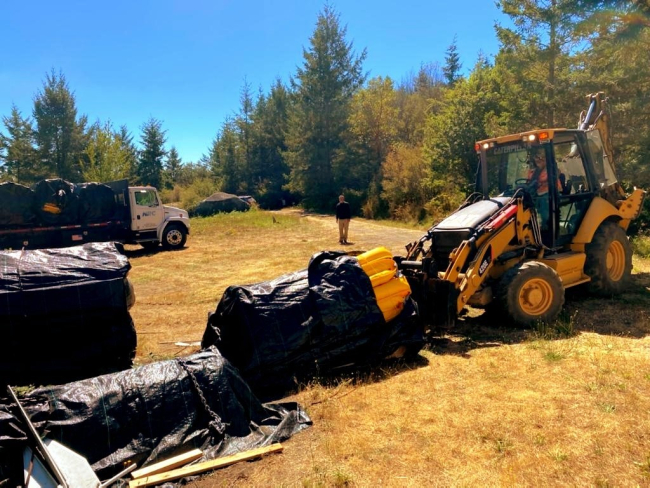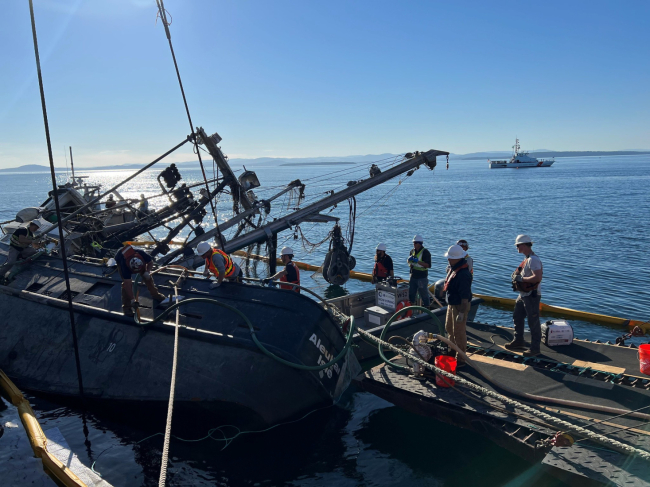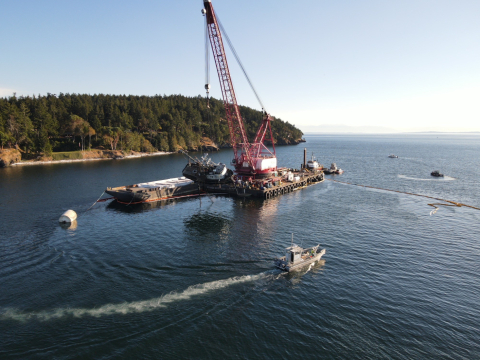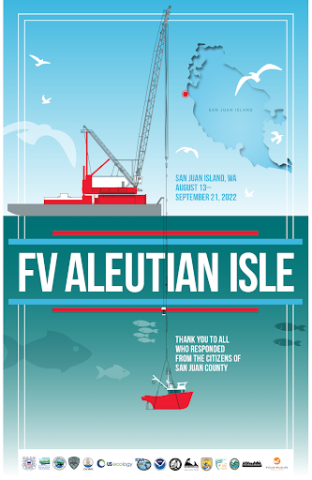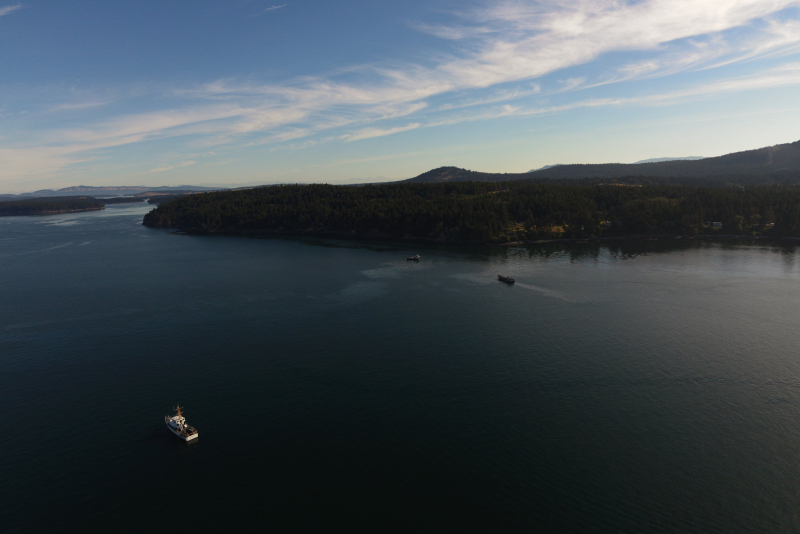
When an oil spill happens, it’s usually not just one agency that responds. Oftentimes, it’s an entire spill response community that bands together to clean up the spill, protect the environment from any impacts, and begin working on recovery.
Each spill response is unique, with many moving parts and entities working together. Some are more complex than others, and require more responders to get the job done. It’s spills like these that bring together those in the spill response community to work toward a common goal. This week, we’d like to share some gratitude for the partners that made a recent spill response possible.
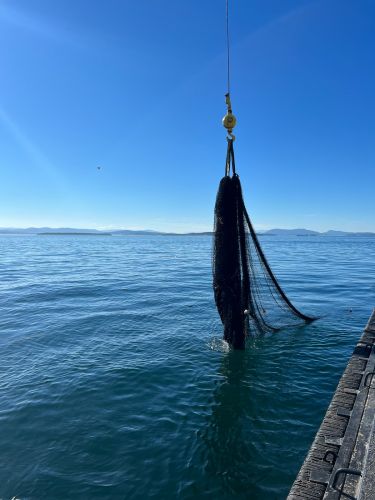
On Aug. 13, 2022, the 58-foot fishing vessel sank off San Juan Island in Washington State. Thankfully, as the F/V Aleutian Isle sank, all five crew members were rescued by a good samaritan vessel. Responders observed a sheen from the vessel’s fuel tanks, spanning about three miles, and gradually entering Canadian waters. Due to the vessel’s location, depth on the bottom, and currents in the area, this would mean a challenging response ahead.
Many government agencies (federal, state, county, tribal), private spill removal organizations, and nongovernmental organizations responded to the incident—including a number of NOAA offices.
Our team at NOAA’s Office of Response and Restoration contributed to resources at risk assessments and oil spill trajectory analyses to anticipate where the spilled oil may drift and what the oil may impact. Our spatial data specialists offered to provide an ERMA® (Environmental Response Management Application) dashboard as a common operational picture for the response. Our marine debris specialists advised on entanglement issues related to the fishing vessel’s nets and put together recovery plans for potential marine mammal impacts. The crew of the Coast Guard Cutter Henry Blake recovered approximately 1,400 feet of netting from the Aleutian Isle.
An Agency of Collaborators

Though OR&R is one of the leading agencies in spill response, we often work closely with other offices right here at NOAA. In the San Juan Island spill, we were aided in numerous ways by our NOAA colleagues. NOAA’s Center for Operational Oceanographic Products and Services created a current prediction model—the high-resolution Salish Sea and Columbia River Operational Forecast System—for on-scene responders to determine slack current windows for the very challenging technical dive and remotely operated vehicle operations.
NOAA’s National Weather Service provided daily and extended marine weather forecasts, and wildfire smoke conditions for responder safety. The National Marine Fisheries Service provided expertise in marine mammal response and deterrence and Endangered Species Act consultations to protect killer whales and other mammals from the oil and the response activities.
The Office of Coast Survey kept the response team up to date on the availability of response assets and equipment. Overall, through collaboration and streamlined data sharing, NOAA teams generated approximately 65 scientific products to assist this complex response.
The Boots on the Ground
When we provide scientific support to an oil spill, it’s up to the boots-on-the-ground responders to implement the information and products we provide into their on scene decision-making process. The U.S. Coast Guard, local and tribal agencies, and contractors are generally the ones doing the heavy lifting of containing the spill and carrying out recovery efforts.
As in the case with the Aleutian Isle, the response efforts included the deployment of over 7,300 feet of pollution boom to contain the spill and protect sensitive areas. Responders also conducted aerial surveys multiple times a day, and monitored for shoreline, wildlife, and air quality impacts. Whale deterrence teams were ready to deploy if needed, and equipment such as skimmers was also at the ready.
The decision was made to try to raise the vessel from its deep resting spot, rather than pump fuel off. Forty days of work by many dedicated response groups led to a successful outcome. On Sept. 17, after weeks of complex dive operations, crews successfully salvaged the Aleutian Isle by rigging cables to lift the vessel from 250 feet below the surface and out of the water.
The vessel was first brought to shallower water for defueling, dewatering, and re-rigging. It was then placed on a barge lined with protective barriers to prevent additional pollution, with the barge being fully boomed as an additional precaution. Once secured, the Aleutian Isle was barged to a mainland facility for assessment.
“We are so pleased to see the vessel safely out of the water,” said U.S. Coast Guard Cmdr. Kira Moody, federal on-scene coordinator representative, in a press release. “The unique environment of the San Juan Islands and location of the vessel made this a complicated and technical response. Through the team’s expertise we were able to overcome any challenge safely and efficiently.”
The Support of a Community
When a spill happens in small communities and remote areas, such as an island, the local resources available can mean the difference between a successful response and a spill with significant impacts. It can be challenging to mobilize the resources needed to isolated locations. Preparedness at a community level for these kinds of incidents is an integral part to the response efforts.
Among the many response agencies involved was the San Juan County Department of Emergency Management, which has made preparedness a focal point in its mission.
“We have done a lot of work in recent years to get equipment stationed on the island,” said San Juan Office of Emergency Management Director Brendan Cowan, local on-scene coordinator, in a Coast Guard press release. “I am thankful that work paid off when we needed it the most. I want to thank everyone involved in this response for their efforts protecting the close-knit community that is the San Juans.”
On Sept. 21, the Aleutian Isle was placed on a salvage barge—no longer posing a threat to the environment and the unique wildlife that depends on it.
“It’s a relief to have the vessel finally out of the water,” said Washington Department of Fish and Wildlife Don Noviello, wildlife branch director in the release. “This area is special and unique. It has an incredible diversity of marine life. The whale deterrence team has spent countless hours monitoring and protecting the Southern Residents [killer whale group] and other species from any sheening.”
In celebration of a successful response, the San Juan County community shared its gratitude with a poster (above) of thanks “to all who responded.” We echo those thanks, and commend our fellow responders on a job well done. It’s communities like those in the spill response world that help keep our coasts clean, and we couldn’t be more grateful!
Happy Thanksgiving, from the spill response team at OR&R!

